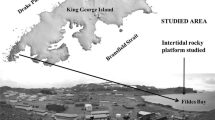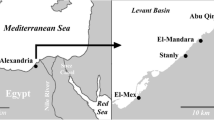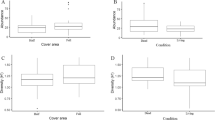Abstract
The community structure of the decapod crustacean fauna of 7 tropical, shallowwater, marine habitats (sandy beaches, mangrove swamps and rocky intertidal habitats on both the Pacific and Caribbean coasts of Panama, and Pocillopora damicornis coral habitat of the Bay of Panama) were examined and analyzed for species composition and relative abundances. Collections from the 7 habitats yielded 4361 individuals, representing 236 species. The number of species per habitat was (Pacific, Caribbean): sandy beach (16, 7); mangrove (20, 17); P. damicornis (53); rocky intertidal (78, 67). There were more species represented by more individuals in the Pacific habitats. An index of faunal similarity was calculated for each pair (Pacific-Caribbean) of habitats. This index is the number of ecologically similar congeneric species which occurred in both habitats expressed as a percentage of the total number of species present in the pair of habitats. For the sandy beach communities there were three Pacific species which were similar to three Caribbean species, a similarity of 6/23 or 26%. The index of similarity for the mangrove communities is 54% and for the rocky intertidal communities it is 37%. The P. damicornis community has affinities with the Pacific rocky intertidal community (18%), with that of the Caribbean rocky intertidal (16%) and with that of Indo-West Pacific pocilloporid corals (20%). A few specialized species dominated each of the communities. The habitats and the number of species accounting for over half of the individuals present are (Pacific, Caribbean): sandy beach (1, 1); mangrove (4, 4); P. damicornis (5); and rocky intertidal (3, 6). Most of the species in each community were represented by one or a few individuals.
Similar content being viewed by others
Literature cited
Abele, L.G.: Semi-terrestrial shrimp (Merguia rhizophorae). Nature, Lond. 236, 661–662 (1970)
—: Comparative habitat diversity and faunal relationships between the Pacific and Caribbean Panamanian decapod Crustacea: a preliminary report with some remarks on the crustacean fauna of Panama. Bull. biol. Soc. Wash. 2, 125–138 (1972a)
—: Introductions of two freshwater decapod crustaceans (Hymenosomatidae and Atyidae) into Central and North America. Crustaceana 23, 209–218 (1972b)
—: Species diversity of decapod crustaceans in marine habitats. Ecology 55, 156–161 (1974)
Crane, J.: Intertidal brachygnathous crabs from the west coast of tropical America with special reference to ecology. Zoologica, N.Y. 32, 69–95 (1947)
Davis, J.H., Jr.: The ecology and geologic role of mangroves in Florida. Pap. Tortugas Lab. 32, 303–412 (1940)
Dexter, D.M.: Comparative community structure of the sandy beaches of Panama. Bull. mar. Sci. 22, 449–462 (1972)
Durham, J.W. and E.C. Allison: The geologic history of Baja California and its marine faunas. Syst. Zool. 9, 47–91 (1960)
— and J.L. Barnard: Stony corals of the eastern Pacific collected by the Velero III and Velero IV. Allan Hancock Pacif. Exped. 16, 1–110 (1952)
Edmondson, C.H.: Xanthidae of Hawaii. Occ. Pap. Bernice P. Bishop Mus. 22, 215–309 (1962)
Efford, I.E.: Feeding in the sand crab Emerita analoga (Stimpson) (Decapoda, Anomura). Crustaceana 10, 167–182 (1966)
—: Neoteny in sand crabs of the genus Emerita (Anomura, Hippidae). Crustaceana 13, 81–93 (1967)
—: Recruitment to sedentary marine populations as exemplified by the sand crab, Emerita analoga (Decapoda, Hippidae). Crustaceana 18, 295–308 (1970)
—: The antennule cleaning setae in the sand crab, Emerita (Decapoda, Hippidae). Crustaceana 21, 316–318 (1971)
Emiliani, C., S. Gartner and B. Lidz: Neogene sedimentation on the Blake Plateau and the emergence of the Central American Isthmus. Palaeogeogr. Palaeoclim. Palaeoecol. 11, 1–10 (1972)
Garth, J.S.: Globopilumnus xantusii (Stimpson), N. Comb., a stridulating crab from the west coast of tropical America, with remarks on discontinuous distribution of some west American and West African genera of brachyrhynchous crabs. Crustaceana 15, 312–318 (1968)
—: On the occurrence in the Eastern Pacific of Indo-West Pacific decapod crustaceans commensal with reef-building corals. Proc. int. Symp. coral Reefs 1, 397–404 (1974)
Glaessner, M.F.: Decapoda. In: Treatise on invertebrate paleontology. Part R. Arthropoda, 4. Vol. 2. pp R400–533. Ed. by R.C. Moore. Colorado: Geological Society of America 1969
Glynn, P.: Ecology of the shallow waters of Panama. Bull. biol. Soc. Wash. 2, 13–30 (1972)
Goodbody, I.: Continuous breeding in populations of two tropical crustaceans, Mysidium columbiae (Zimmer) and Emerita portoricensis Schmitt. Ecology 46, 195–197 (1965)
Hansen, A.J.: The larval development of the sand crab Hippa cubensis (De Saussure) in the laboratory. Crustaceana 16, 113–118 (1969)
Hartnoll, R.G.: Notes on the marine grapsid crabs of Jamaica. Proc. Linn. Soc. Lond. 176, 113–147 (1965)
Hildebrand, S.F.: The Panama Canal as a passageway for fishes, with lists and remarks on the fishes and invertebrates observed. Zoologica, N.Y. 24 (3), 15–45 (1939)
Hurlbert, S.H.: The nonconcept of species diversity: a critique and alternative parameters. Ecology 52, 577–586 (1971)
Jones, M.L. (Ed.): The Panamic biota: some observations prior to a sea-level canal. Bull. biol. Soc. Wash. 2, 1–269 (1972)
Knight, M.D.: The larval development of the sand crab Emerita rathbunae Schmitt (Decapoda, Hippidae). Pacif. Sci. 21, 58–76 (1967)
Knudsen, J.W.: Trapezia and Tetralia (Decapoda, Brachyura, Xanthidae) as obligate ectoparasites of pocilloporid and acroporid corals. Pacif. Sci. 21, 51–57 (1967)
McCosker, J.E. and C.E. Dawson: Biotic passage through the Panama Canal, with particular reference to fishes. Mar. Biol. 30, 343–351 (1975)
McDermott, J.J.: The predation of oysters and barnacles by crabs of the family Xanthidae. Proc. Pa Acad. Sci. 34, 199–211 (1960)
McNaughton, S.J.: Relationships among functional properties of California grasslands. Nature, Lond. 216, 168–169 (1967)
— and L.L. Wolf: Dominance and the niche in ecological systems. Science, N.Y. 167, 131–139 (1970)
Monod, Th.: Hippidea et Brachyura ouest-africains. Mem. Inst. fr. Afr. noire 45, 1–674 (1956)
Olsson, A.A.: Origin of the existing Panamic molluscan biotas in terms of their geologic history and their separation by the Isthmian land barrier. Bull. biol. Soc. Wash. 2, 117–123 (1972)
Patton, W.K.: Community structure among the animals inhabiting the coral Pocillopora damicornia at Heron Island, Australia. In: Symbiosis in the sea, pp 219–243. Ed. by W.B. Vernberg. Columbia, South Carolina: University of South Carolina Press 1974
Powell, N.A.: The marine bryozoa near the Panama Canal. Bull. mar. Sci. 21, 766–778 (1971)
Rathbun, M.J.: Decapod crustaceans from the Panama region. Bull. U.S. natn. Mus. 103, 123–184 (1918)
Rubinoff, R.W. and I. Rubinoff: Interoceanic colonization of a marine goby through the Panama Canal. Nature, Lond. 217, 476–478 (1968)
—: Observations on the migration of a marine goby through the Panama Canal. Copeia 1969, 395–397 (1969)
Warner, G.F.: The occurrence and distribution of carbs in a Jamaican mangrove swamp. J. Anim. Ecol. 38, 379–389 (1969)
Whitmore, F.C., Jr. and R.H. Stewart: Miocene mammals and Central American Seaways. Science, N.Y. 148, 180–185 (1965)
Whittaker, R.H.: Dominance and diversity in land plant communities. Science, N.Y. 147, 250–260 (1965)
Woodring, W.P.: The Panama land bridge as a sea barrier. Proc. Am. phil. Soc. 110, 425–433 (1966)
Author information
Authors and Affiliations
Additional information
Communicated by M.R. Tripp, Newark
Rights and permissions
About this article
Cite this article
Abele, L.G. Comparative species composition and relative abundance of decapod crustaceans in marine habitats of Panamá. Mar. Biol. 38, 263–278 (1976). https://doi.org/10.1007/BF00388939
Accepted:
Issue Date:
DOI: https://doi.org/10.1007/BF00388939




